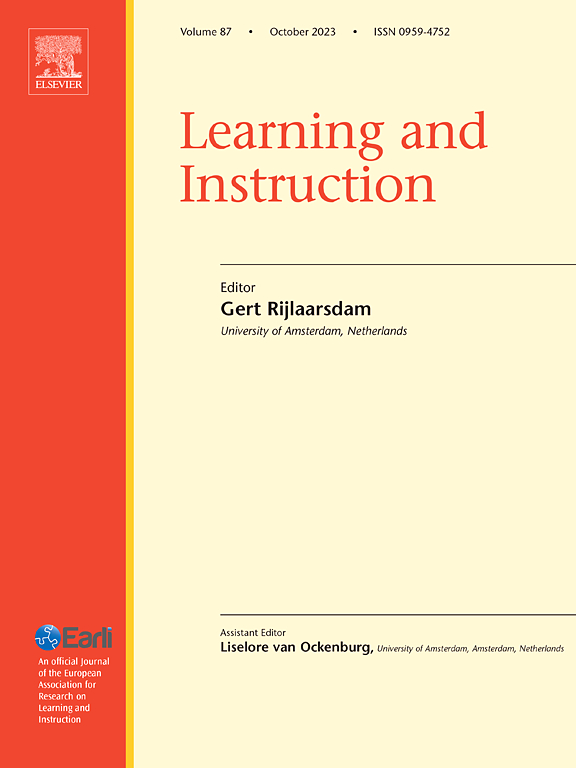训练儿童的空间语言技能可以提高他们对数字大小的理解
IF 4.9
1区 教育学
Q1 EDUCATION & EDUCATIONAL RESEARCH
引用次数: 0
摘要
背景越来越多的证据表明,空间语言技能与早期数字发展(即口头数字技能和数字大小理解)有关。然而,对这种关联进行因果解释的干预研究在很大程度上是缺失的。目的探讨空间语言技能训练对儿童基本数字技能发展的影响。干预组54例,未训练对照组72例,年龄4 ~ 6岁(年龄≥60.58个月)。方法采用测试前-后对照组设计,以4 ~ 8名儿童为小组,进行6次训练,每次训练约20 min,训练时间以每周2次为主。培训的重点是对前面、后面、左边和右边的空间术语的产生和理解,并评估对数字大小理解和口头数字技能的影响。结果对比实验组和对照组在测试前后的表现,实验组在空间语言的产生和理解以及数字大小的理解上有显著提高,但在口头数字技能上没有显著提高。结论这些发现为儿童空间语言技能与其数字大小理解发展之间的因果关系提供了第一个证据。这突出了掌握特定的空间语言术语与儿童早期数字发展的相关性。本文章由计算机程序翻译,如有差异,请以英文原文为准。
Training children’s spatial language skills improves their numerical magnitude understanding
Background
There is accumulating evidence suggesting that spatial language skills are associated with early numerical development (i.e., verbal number skills and numerical magnitude understanding). However, intervention studies allowing for a causal interpretation of this association are largely missing.
Aims
Therefore, we aimed at investigating the effects of training children's spatial language skills on the development of basic numerical skills.
Sample
The intervention group comprised n = 54 and the non-trained control group n = 72 4-6-year-old children (Mage = 60.58 months).
Methods
In a pre-post-test control group design small groups of four to eight children were trained six times (mostly twice a week) for about 20 min each. The training focused on production and comprehension of the spatial terms in front of, behind, to the left, and to the right with effects on numerical magnitude understanding and verbal number skills being evaluated.
Results
Comparing training and control group on performance gains between pre- and post-test revealed significantly higher gains for the intervention group in spatial language production and comprehension as well as numerical magnitude understanding, but not verbal number skills.
Conclusion
These findings provide first evidence for a causal link between children's spatial language skills and the development of their numerical magnitude understanding. This highlights the relevance of mastering specific spatial language terms for children's early numerical development.
求助全文
通过发布文献求助,成功后即可免费获取论文全文。
去求助
来源期刊

Learning and Instruction
Multiple-
CiteScore
11.30
自引率
4.80%
发文量
109
期刊介绍:
As an international, multi-disciplinary, peer-refereed journal, Learning and Instruction provides a platform for the publication of the most advanced scientific research in the areas of learning, development, instruction and teaching. The journal welcomes original empirical investigations. The papers may represent a variety of theoretical perspectives and different methodological approaches. They may refer to any age level, from infants to adults and to a diversity of learning and instructional settings, from laboratory experiments to field studies. The major criteria in the review and the selection process concern the significance of the contribution to the area of learning and instruction, and the rigor of the study.
 求助内容:
求助内容: 应助结果提醒方式:
应助结果提醒方式:


